boot SKODA FABIA 2013 2.G / 5J Owner's Guide
[x] Cancel search | Manufacturer: SKODA, Model Year: 2013, Model line: FABIA, Model: SKODA FABIA 2013 2.G / 5JPages: 223, PDF Size: 12.77 MB
Page 66 of 223
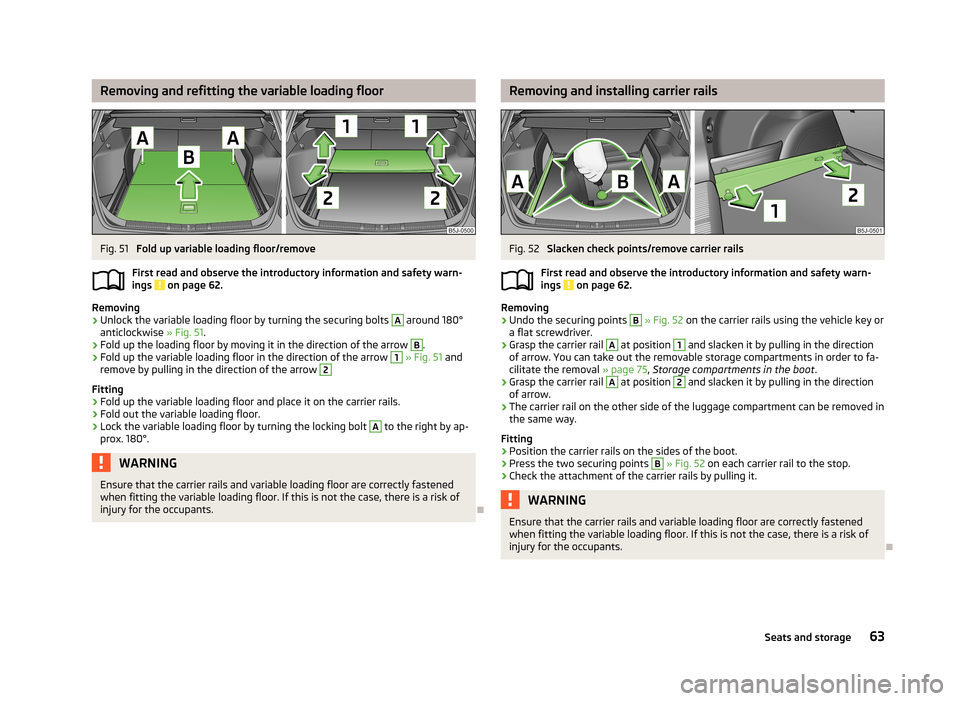
Removing and refitting the variable loading floorFig. 51
Fold up variable loading floor/remove
First read and observe the introductory information and safety warn-
ings
on page 62.
Removing
›
Unlock the variable loading floor by turning the securing bolts
A
around 180°
anticlockwise » Fig. 51.
›
Fold up the loading floor by moving it in the direction of the arrow
B
.
›
Fold up the variable loading floor in the direction of the arrow
1
» Fig. 51 and
remove by pulling in the direction of the arrow
2
Fitting
›
Fold up the variable loading floor and place it on the carrier rails.
›
Fold out the variable loading floor.
›
Lock the variable loading floor by turning the locking bolt
A
to the right by ap-
prox. 180°.
WARNINGEnsure that the carrier rails and variable loading floor are correctly fastened
when fitting the variable loading floor. If this is not the case, there is a risk of
injury for the occupants.
Removing and installing carrier railsFig. 52
Slacken check points/remove carrier rails
First read and observe the introductory information and safety warn- ings
on page 62.
Removing
›
Undo the securing points
B
» Fig. 52 on the carrier rails using the vehicle key or
a flat screwdriver.
›
Grasp the carrier rail
A
at position
1
and slacken it by pulling in the direction
of arrow. You can take out the removable storage compartments in order to fa-
cilitate the removal » page 75, Storage compartments in the boot .
›
Grasp the carrier rail
A
at position
2
and slacken it by pulling in the direction
of arrow.
›
The carrier rail on the other side of the luggage compartment can be removed in
the same way.
Fitting
›
Position the carrier rails on the sides of the boot.
›
Press the two securing points
B
» Fig. 52 on each carrier rail to the stop.
›
Check the attachment of the carrier rails by pulling it.
WARNINGEnsure that the carrier rails and variable loading floor are correctly fastened
when fitting the variable loading floor. If this is not the case, there is a risk of
injury for the occupants.
63Seats and storage
Page 67 of 223
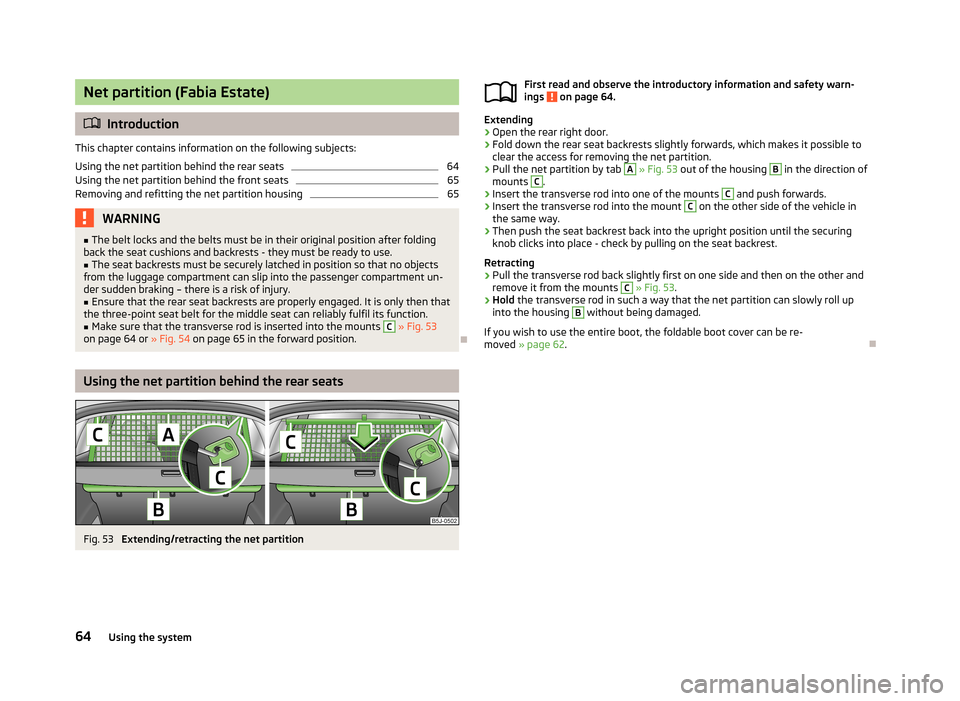
Net partition (Fabia Estate)
Introduction
This chapter contains information on the following subjects:
Using the net partition behind the rear seats
64
Using the net partition behind the front seats
65
Removing and refitting the net partition housing
65WARNING■ The belt locks and the belts must be in their original position after folding
back the seat cushions and backrests - they must be ready to use.■
The seat backrests must be securely latched in position so that no objects
from the luggage compartment can slip into the passenger compartment un- der sudden braking – there is a risk of injury.
■
Ensure that the rear seat backrests are properly engaged. It is only then that
the three-point seat belt for the middle seat can reliably fulfil its function.
■
Make sure that the transverse rod is inserted into the mounts
C
» Fig. 53
on page 64 or » Fig. 54 on page 65 in the forward position.
Using the net partition behind the rear seats
Fig. 53
Extending/retracting the net partition
First read and observe the introductory information and safety warn-
ings on page 64.
Extending
›
Open the rear right door.
›
Fold down the rear seat backrests slightly forwards, which makes it possible to
clear the access for removing the net partition.
›
Pull the net partition by tab
A
» Fig. 53 out of the housing
B
in the direction of
mounts
C
.
›
Insert the transverse rod into one of the mounts
C
and push forwards.
›
Insert the transverse rod into the mount
C
on the other side of the vehicle in
the same way.
›
Then push the seat backrest back into the upright position until the securing
knob clicks into place - check by pulling on the seat backrest.
Retracting
›
Pull the transverse rod back slightly first on one side and then on the other and
remove it from the mounts
C
» Fig. 53 .
›
Hold the transverse rod in such a way that the net partition can slowly roll up
into the housing
B
without being damaged.
If you wish to use the entire boot, the foldable boot cover can be re- moved » page 62 .
64Using the system
Page 69 of 223
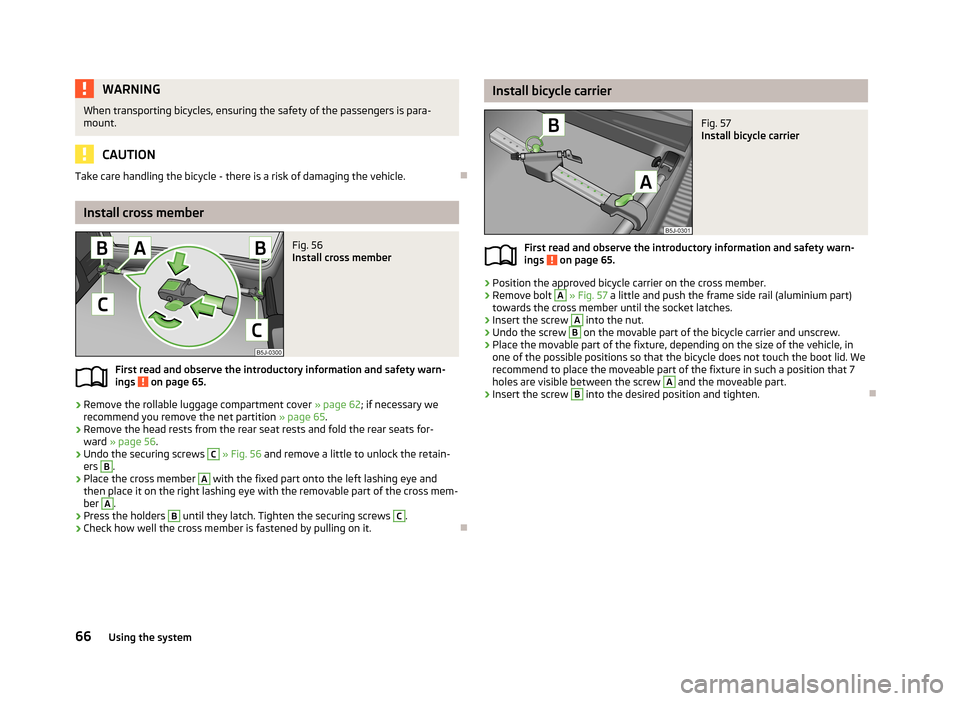
WARNINGWhen transporting bicycles, ensuring the safety of the passengers is para-
mount.
CAUTION
Take care handling the bicycle - there is a risk of damaging the vehicle.
Install cross member
Fig. 56
Install cross member
First read and observe the introductory information and safety warn- ings on page 65.
›
Remove the rollable luggage compartment cover » page 62; if necessary we
recommend you remove the net partition » page 65.
›
Remove the head rests from the rear seat rests and fold the rear seats for-
ward » page 56 .
›
Undo the securing screws
C
» Fig. 56 and remove a little to unlock the retain-
ers
B
.
›
Place the cross member
A
with the fixed part onto the left lashing eye and
then place it on the right lashing eye with the removable part of the cross mem-
ber
A
.
›
Press the holders
B
until they latch. Tighten the securing screws
C
.
›
Check how well the cross member is fastened by pulling on it.
Install bicycle carrierFig. 57
Install bicycle carrier
First read and observe the introductory information and safety warn- ings on page 65.
›
Position the approved bicycle carrier on the cross member.
›
Remove bolt
A
» Fig. 57 a little and push the frame side rail (aluminium part)
towards the cross member until the socket latches.
›
Insert the screw
A
into the nut.
›
Undo the screw
B
on the movable part of the bicycle carrier and unscrew.
›
Place the movable part of the fixture, depending on the size of the vehicle, in
one of the possible positions so that the bicycle does not touch the boot lid. We
recommend to place the moveable part of the fixture in such a position that 7 holes are visible between the screw
A
and the moveable part.
›
Insert the screw
B
into the desired position and tighten.
66Using the system
Page 70 of 223
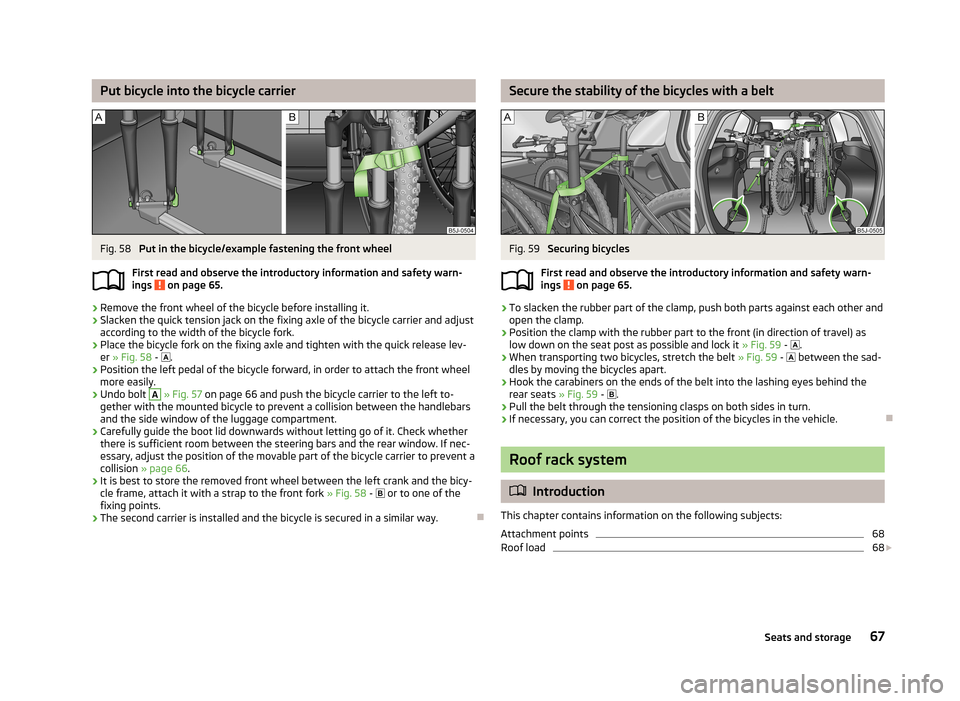
Put bicycle into the bicycle carrierFig. 58
Put in the bicycle/example fastening the front wheel
First read and observe the introductory information and safety warn-
ings
on page 65.
›
Remove the front wheel of the bicycle before installing it.
›
Slacken the quick tension jack on the fixing axle of the bicycle carrier and adjust
according to the width of the bicycle fork.
›
Place the bicycle fork on the fixing axle and tighten with the quick release lev- er » Fig. 58 -
.
›
Position the left pedal of the bicycle forward, in order to attach the front wheel
more easily.
›
Undo bolt
A
» Fig. 57 on page 66 and push the bicycle carrier to the left to-
gether with the mounted bicycle to prevent a collision between the handlebars
and the side window of the luggage compartment.
›
Carefully guide the boot lid downwards without letting go of it. Check whether there is sufficient room between the steering bars and the rear window. If nec-essary, adjust the position of the movable part of the bicycle carrier to prevent a
collision » page 66 .
›
It is best to store the removed front wheel between the left crank and the bicy-
cle frame, attach it with a strap to the front fork » Fig. 58 -
or to one of the
fixing points.
›
The second carrier is installed and the bicycle is secured in a similar way.
Secure the stability of the bicycles with a beltFig. 59
Securing bicycles
First read and observe the introductory information and safety warn-
ings
on page 65.
›
To slacken the rubber part of the clamp, push both parts against each other and
open the clamp.
›
Position the clamp with the rubber part to the front (in direction of travel) as low down on the seat post as possible and lock it » Fig. 59 -
.
›
When transporting two bicycles, stretch the belt » Fig. 59 -
between the sad-
dles by moving the bicycles apart.
›
Hook the carabiners on the ends of the belt into the lashing eyes behind the rear seats » Fig. 59 -
.
›
Pull the belt through the tensioning clasps on both sides in turn.
›
If necessary, you can correct the position of the bicycles in the vehicle.
Roof rack system
Introduction
This chapter contains information on the following subjects:
Attachment points
68
Roof load
68
67Seats and storage
Page 71 of 223
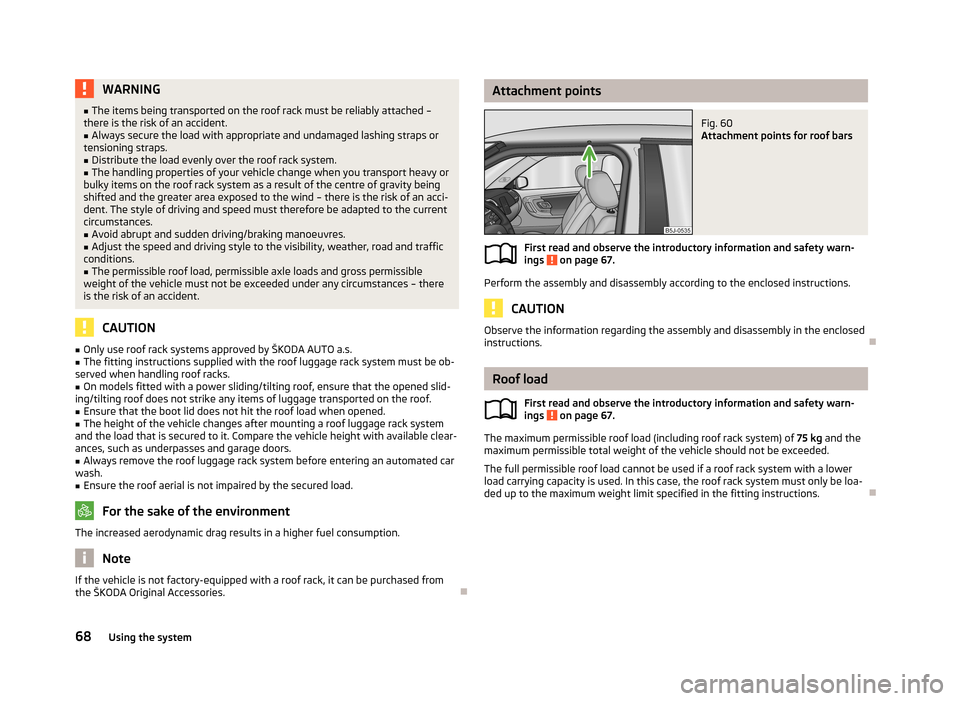
WARNING■The items being transported on the roof rack must be reliably attached –
there is the risk of an accident.■
Always secure the load with appropriate and undamaged lashing straps or
tensioning straps.
■
Distribute the load evenly over the roof rack system.
■
The handling properties of your vehicle change when you transport heavy or
bulky items on the roof rack system as a result of the centre of gravity being
shifted and the greater area exposed to the wind – there is the risk of an acci-
dent. The style of driving and speed must therefore be adapted to the current
circumstances.
■
Avoid abrupt and sudden driving/braking manoeuvres.
■
Adjust the speed and driving style to the visibility, weather, road and traffic
conditions.
■
The permissible roof load, permissible axle loads and gross permissible
weight of the vehicle must not be exceeded under any circumstances – there is the risk of an accident.
CAUTION
■ Only use roof rack systems approved by ŠKODA AUTO a.s.■The fitting instructions supplied with the roof luggage rack system must be ob-
served when handling roof racks.■
On models fitted with a power sliding/tilting roof, ensure that the opened slid-
ing/tilting roof does not strike any items of luggage transported on the roof.
■
Ensure that the boot lid does not hit the roof load when opened.
■
The height of the vehicle changes after mounting a roof luggage rack system
and the load that is secured to it. Compare the vehicle height with available clear-
ances, such as underpasses and garage doors.
■
Always remove the roof luggage rack system before entering an automated car
wash.
■
Ensure the roof aerial is not impaired by the secured load.
For the sake of the environment
The increased aerodynamic drag results in a higher fuel consumption.
Note
If the vehicle is not factory-equipped with a roof rack, it can be purchased from
the ŠKODA Original Accessories.
Attachment pointsFig. 60
Attachment points for roof bars
First read and observe the introductory information and safety warn-
ings on page 67.
Perform the assembly and disassembly according to the enclosed instructions.
CAUTION
Observe the information regarding the assembly and disassembly in the enclosed
instructions.
Roof load
First read and observe the introductory information and safety warn-
ings
on page 67.
The maximum permissible roof load (including roof rack system) of 75 kg and the
maximum permissible total weight of the vehicle should not be exceeded.
The full permissible roof load cannot be used if a roof rack system with a lower
load carrying capacity is used. In this case, the roof rack system must only be loa-
ded up to the maximum weight limit specified in the fitting instructions.
68Using the system
Page 73 of 223
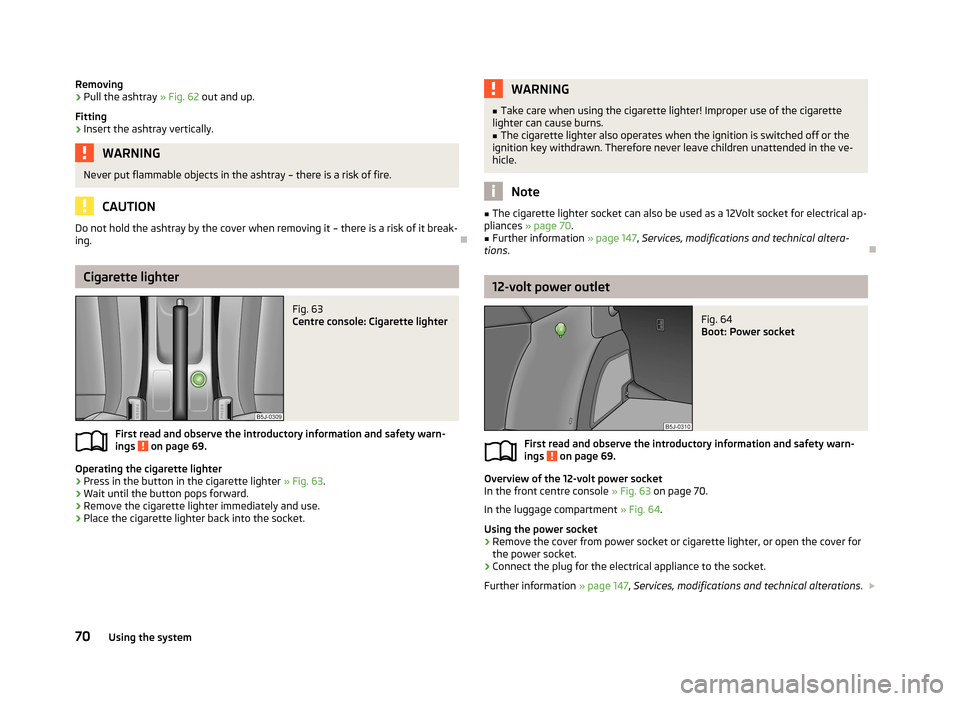
Removing›Pull the ashtray » Fig. 62 out and up.
Fitting›
Insert the ashtray vertically.
WARNINGNever put flammable objects in the ashtray – there is a risk of fire.
CAUTION
Do not hold the ashtray by the cover when removing it – there is a risk of it break- ing.
Cigarette lighter
Fig. 63
Centre console: Cigarette lighter
First read and observe the introductory information and safety warn-
ings on page 69.
Operating the cigarette lighter
›
Press in the button in the cigarette lighter » Fig. 63.
›
Wait until the button pops forward.
›
Remove the cigarette lighter immediately and use.
›
Place the cigarette lighter back into the socket.
WARNING■
Take care when using the cigarette lighter! Improper use of the cigarette
lighter can cause burns.■
The cigarette lighter also operates when the ignition is switched off or the
ignition key withdrawn. Therefore never leave children unattended in the ve-
hicle.
Note
■ The cigarette lighter socket can also be used as a 12Volt socket for electrical ap-
pliances » page 70 .■
Further information » page 147, Services, modifications and technical altera-
tions .
12-volt power outlet
Fig. 64
Boot: Power socket
First read and observe the introductory information and safety warn-
ings on page 69.
Overview of the 12-volt power socket
In the front centre console » Fig. 63 on page 70.
In the luggage compartment » Fig. 64.
Using the power socket
›
Remove the cover from power socket or cigarette lighter, or open the cover for
the power socket.
›
Connect the plug for the electrical appliance to the socket.
Further information » page 147, Services, modifications and technical alterations .
70Using the system
Page 75 of 223
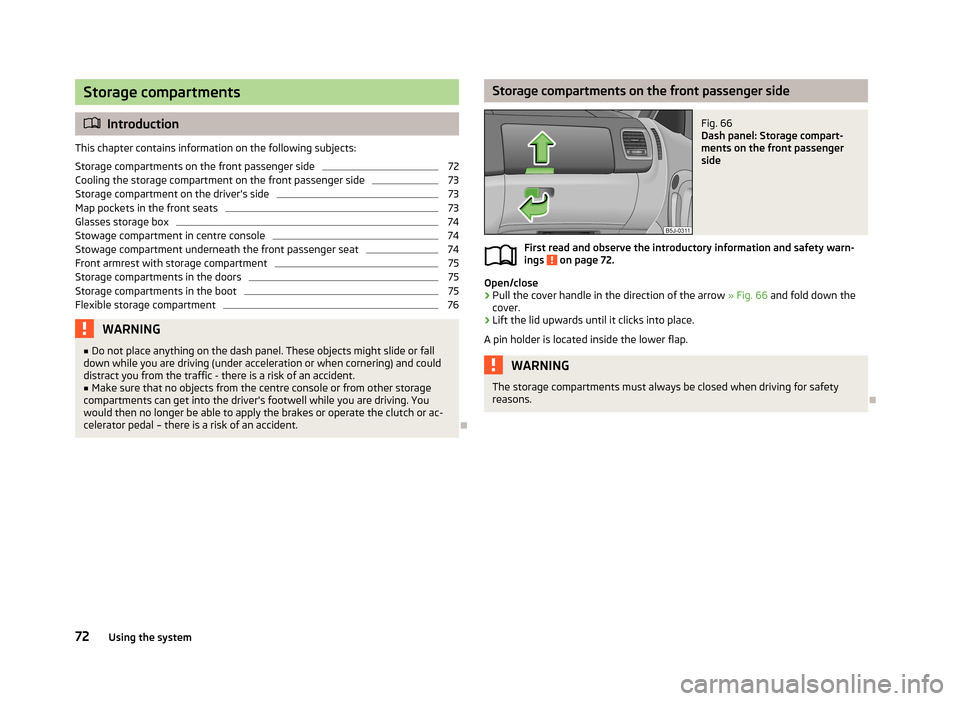
Storage compartments
Introduction
This chapter contains information on the following subjects:
Storage compartments on the front passenger side
72
Cooling the storage compartment on the front passenger side
73
Storage compartment on the driver's side
73
Map pockets in the front seats
73
Glasses storage box
74
Stowage compartment in centre console
74
Stowage compartment underneath the front passenger seat
74
Front armrest with storage compartment
75
Storage compartments in the doors
75
Storage compartments in the boot
75
Flexible storage compartment
76WARNING■ Do not place anything on the dash panel. These objects might slide or fall
down while you are driving (under acceleration or when cornering) and could
distract you from the traffic - there is a risk of an accident.■
Make sure that no objects from the centre console or from other storage
compartments can get into the driver's footwell while you are driving. You
would then no longer be able to apply the brakes or operate the clutch or ac-
celerator pedal – there is a risk of an accident.
Storage compartments on the front passenger sideFig. 66
Dash panel: Storage compart-
ments on the front passenger
side
First read and observe the introductory information and safety warn-
ings on page 72.
Open/close
›
Pull the cover handle in the direction of the arrow » Fig. 66 and fold down the
cover.
›
Lift the lid upwards until it clicks into place.
A pin holder is located inside the lower flap.
WARNINGThe storage compartments must always be closed when driving for safety
reasons.
72Using the system
Page 78 of 223
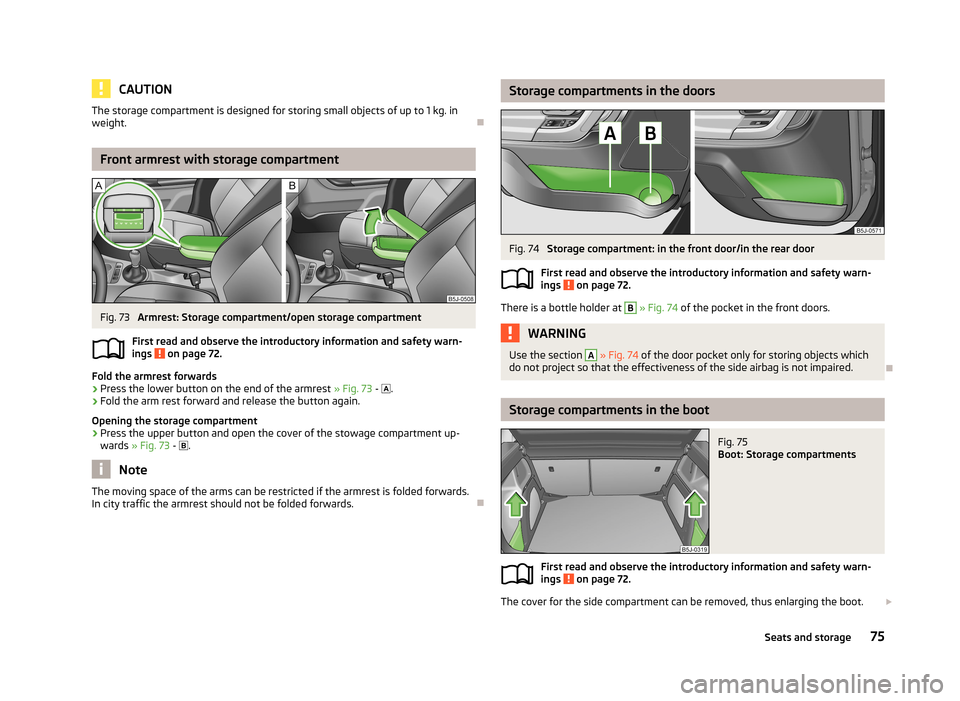
CAUTIONThe storage compartment is designed for storing small objects of up to 1 kg. in
weight.
Front armrest with storage compartment
Fig. 73
Armrest: Storage compartment/open storage compartment
First read and observe the introductory information and safety warn- ings
on page 72.
Fold the armrest forwards
›
Press the lower button on the end of the armrest » Fig. 73 -
.
›
Fold the arm rest forward and release the button again.
Opening the storage compartment
›
Press the upper button and open the cover of the stowage compartment up- wards » Fig. 73 -
.
Note
The moving space of the arms can be restricted if the armrest is folded forwards.
In city traffic the armrest should not be folded forwards.
Storage compartments in the doorsFig. 74
Storage compartment: in the front door/in the rear door
First read and observe the introductory information and safety warn- ings
on page 72.
There is a bottle holder at
B
» Fig. 74 of the pocket in the front doors.
WARNINGUse the section A » Fig. 74 of the door pocket only for storing objects which
do not project so that the effectiveness of the side airbag is not impaired.
Storage compartments in the boot
Fig. 75
Boot: Storage compartments
First read and observe the introductory information and safety warn-
ings on page 72.
The cover for the side compartment can be removed, thus enlarging the boot.
75Seats and storage
Page 79 of 223
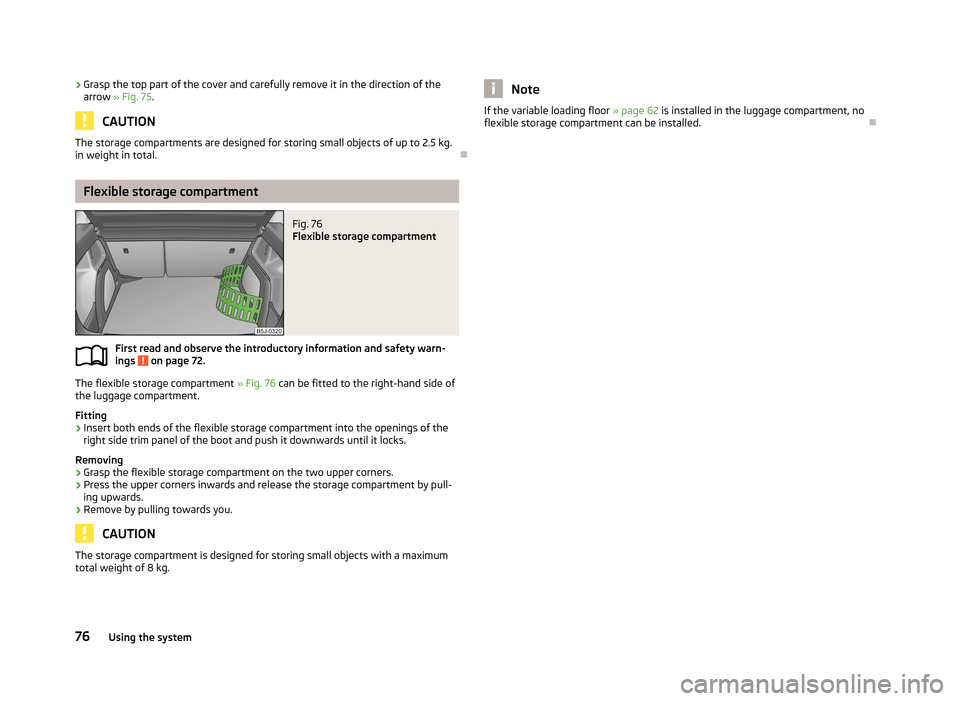
›Grasp the top part of the cover and carefully remove it in the direction of the
arrow » Fig. 75 .
CAUTION
The storage compartments are designed for storing small objects of up to 2.5 kg.
in weight in total.
Flexible storage compartment
Fig. 76
Flexible storage compartment
First read and observe the introductory information and safety warn-
ings on page 72.
The flexible storage compartment » Fig. 76 can be fitted to the right-hand side of
the luggage compartment.
Fitting
›
Insert both ends of the flexible storage compartment into the openings of the right side trim panel of the boot and push it downwards until it locks.
Removing
›
Grasp the flexible storage compartment on the two upper corners.
›
Press the upper corners inwards and release the storage compartment by pull-
ing upwards.
›
Remove by pulling towards you.
CAUTION
The storage compartment is designed for storing small objects with a maximum
total weight of 8 kg.NoteIf the variable loading floor » page 62 is installed in the luggage compartment, no
flexible storage compartment can be installed.
76Using the system
Page 124 of 223
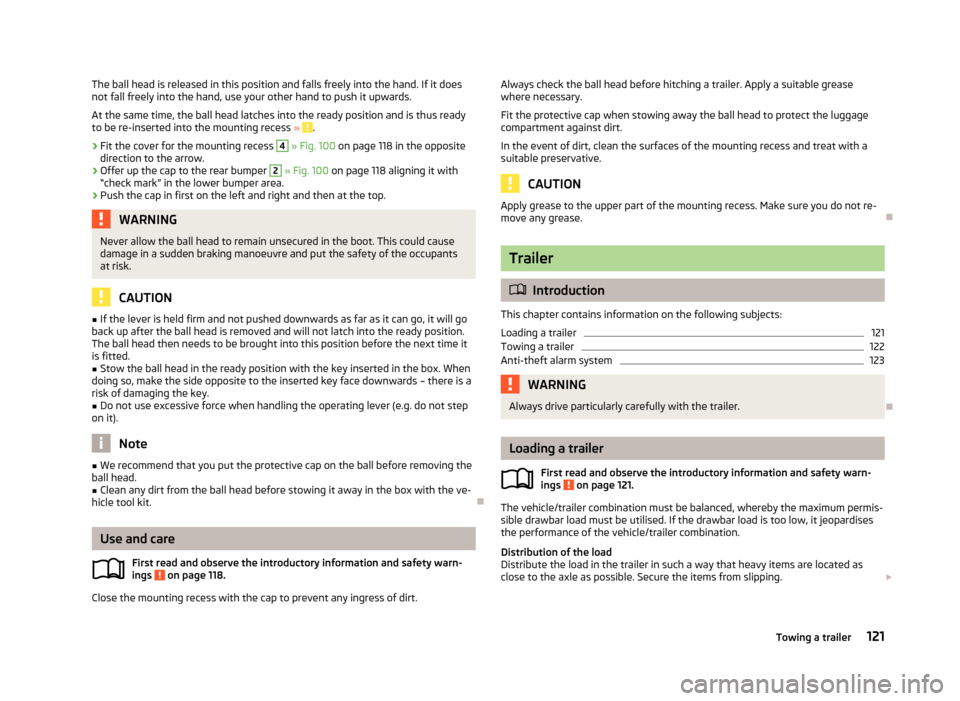
The ball head is released in this position and falls freely into the hand. If it does
not fall freely into the hand, use your other hand to push it upwards.
At the same time, the ball head latches into the ready position and is thus readyto be re-inserted into the mounting recess »
.
›
Fit the cover for the mounting recess
4
» Fig. 100 on page 118 in the opposite
direction to the arrow.
›
Offer up the cap to the rear bumper
2
» Fig. 100 on page 118 aligning it with
“check mark” in the lower bumper area.
›
Push the cap in first on the left and right and then at the top.
WARNINGNever allow the ball head to remain unsecured in the boot. This could cause damage in a sudden braking manoeuvre and put the safety of the occupantsat risk.
CAUTION
■ If the lever is held firm and not pushed downwards as far as it can go, it will go
back up after the ball head is removed and will not latch into the ready position.
The ball head then needs to be brought into this position before the next time it
is fitted.■
Stow the ball head in the ready position with the key inserted in the box. When
doing so, make the side opposite to the inserted key face downwards – there is a
risk of damaging the key.
■
Do not use excessive force when handling the operating lever (e.g. do not step
on it).
Note
■ We recommend that you put the protective cap on the ball before removing the
ball head.■
Clean any dirt from the ball head before stowing it away in the box with the ve-
hicle tool kit.
Use and care
First read and observe the introductory information and safety warn-
ings
on page 118.
Close the mounting recess with the cap to prevent any ingress of dirt.
Always check the ball head before hitching a trailer. Apply a suitable grease where necessary.
Fit the protective cap when stowing away the ball head to protect the luggage
compartment against dirt.
In the event of dirt, clean the surfaces of the mounting recess and treat with a
suitable preservative.
CAUTION
Apply grease to the upper part of the mounting recess. Make sure you do not re-
move any grease.
Trailer
Introduction
This chapter contains information on the following subjects:
Loading a trailer
121
Towing a trailer
122
Anti-theft alarm system
123WARNINGAlways drive particularly carefully with the trailer.
Loading a trailer
First read and observe the introductory information and safety warn-
ings
on page 121.
The vehicle/trailer combination must be balanced, whereby the maximum permis-
sible drawbar load must be utilised. If the drawbar load is too low, it jeopardises the performance of the vehicle/trailer combination.
Distribution of the load
Distribute the load in the trailer in such a way that heavy items are located as close to the axle as possible. Secure the items from slipping.
121Towing a trailer